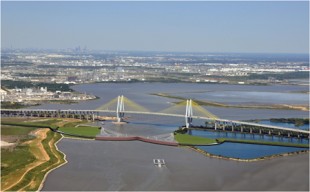Sept. 24-25 conference will explore ways to protect from next big storm
It has been five years since Hurricane Ike struck Galveston, battered Houston and inundated coastal areas of Southeast Texas and Western Louisiana with an unprecedented storm surge.
Ike had already killed more than 70 people in the Caribbean before entering the Gulf of Mexico, and more than a million people jammed Houston-area roads to flee the storm, which struck Galveston Island as a Category 2 early on the morning of Sept. 13, 2008. Hurricane-force winds extended as much as 120 miles from the eye, and Ike pushed a 15- to 20-foot surge of water over Bolivar Peninsula.

The SSPEED-proposed Centennial Gate would provide storm surge protection to the Houston Ship Channel.
Ike’s $29.5 billion economic toll makes it the third-costliest hurricane in U.S. history, but a detailed post-storm analysis — one of the most extensive ever conducted — showed that Ike could have been much worse.
“Studying Ike opened our eyes to the true ‘worst-case’ storm scenario for Houston and Galveston, and it showed us ways that our region could avoid catastrophic damage from future storms,” said Phil Bedient, director of Rice University’s Severe Storm Prediction, Education and Evacuation from Disasters (SSPEED) Center, who co-led the $4.5 million Ike study with SSPEED Co-director Jim Blackburn.
Bedient, Rice’s Herman Brown Professor of Engineering, and Blackburn, professor in the practice of environmental law in Rice’s Department of Civil and Environmental Engineering, will continue their efforts to build public support for regional storm protection at a two-day conference Sept. 24-25 at Rice’s BioScience Research Collaborative titled “Hurricane Ike: 5 Years Later.” The conference, which will present research findings and recommendations for hurricane preparedness, is intended for a broad audience of concerned citizens, business and industry leaders, emergency managers, governmental officials and academic researchers.
The conference will feature keynote speeches by Houston Mayor Annise Parker ’78 and Port of Houston Authority Chair Janiece Longoria. Bill Read, former director of the National Hurricane Center, will also speak, and there will be discussions of both structural and nonstructural storm protection projects, including two proposed by SSPEED: the Centennial Gate, a large surge gate near the Fred Hartman Bridge that would provide storm surge protection for the Houston Ship Channel, and the Lone Star Coastal National Recreation Area (LSCNRA), a coastal green-space buffer that would extend from Chambers County to Matagorda County.
The conference will also include discussions of 2012’s Hurricane Sandy, the second-costliest hurricane in U.S. history. New York City Department of Environmental Protection’s Kathryn Garcia and American Red Cross of Greater New York’s Kelly McKinney will each give presentations on Sandy risk and response strategies.
The conference is open to members of the Rice community, but reservations are required. To attend, email Erin Baker at erin.baker@rice.edu.


Leave a Reply